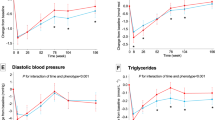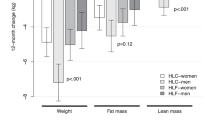Abstract
OBJECTIVE: To examine the relationship between waist circumference and cardiovascular risk factors during weight loss, and to consider possible waist reduction targets for weight management. DESIGN: Single strand six month weight loss study on food based diets in 110 women aged 18–68 y, and body mass index≥25 kg/m2 set at an outpatient clinic. MAIN OUTCOME MEASURES: Waist circumference, weight, body mass index (BMI), total plasma cholesterol, low (LDL) and high density lipoprotein (HDL) cholesterol, triglyceride, and blood pressure. RESULTS: Anthropometric and metabolic measurements improved with mean weight loss of 4.9 (s.e.m.±0.4) kg at three months and 6.2 (s.e.m.±0.4) kg at six months. Weight loss closely related to waist reduction (% Weight loss=0.85×Waist reduction (cm) – 2.09; r=0.79). The proportion of subjects with waist circumference below Action Level 1 (<80 cm) or above Action Level 2 (≥88 cm) were 9 and 60% at baseline, 29 and 38% at three months and 36 and 33% at six months. Waist reduction (adjusted for age, smoking, alcohol consumption, diet treatment and baseline dependent and independent variables) correlated significantly with falls in total cholesterol (r=0.31; P<0.01), LDL cholesterol (r=0.35; P<0.01) and diastolic blood pressure (r=0.32; P<0.01), but not significantly with HDL cholesterol, triglyceride or systolic blood pressure. BMI showed similar correlations, whereas waist to hip ratio changes were not associated with changes in any cardiovascular risk factors. Amongst those whose waist fell by ≥5 cm, 45 at three months and 43 at six months, there were ≥10% improvements in at least one risk factor for 71 and 84% respectively. Amongst those whose waist fell by 5–10 cm, 40 women at three months and 30 at six months, at least one risk factor improved by ≥10% in 70% and in 83% respectively. CONCLUSIONS: Waist reduction of 5–10 cm in Caucasian women, across a range of baseline BMI 25–50 kg/m2 or waist circumference 72–133 cm, may be used as guideline to encourage overweight women to achieve a realistic target with a high probability of health benefits.
This is a preview of subscription content, access via your institution
Access options
Subscribe to this journal
Receive 12 print issues and online access
$259.00 per year
only $21.58 per issue
Buy this article
- Purchase on Springer Link
- Instant access to full article PDF
Prices may be subject to local taxes which are calculated during checkout
Similar content being viewed by others
Author information
Authors and Affiliations
Rights and permissions
About this article
Cite this article
Han, T., Richmond, P., Avenell, A. et al. Waist circumference reduction and cardiovascular benefits during weight loss in women. Int J Obes 21, 127–134 (1997). https://doi.org/10.1038/sj.ijo.0800377
Received:
Revised:
Accepted:
Issue Date:
DOI: https://doi.org/10.1038/sj.ijo.0800377
Keywords
This article is cited by
-
Effect of a six-week times restricted eating intervention on the body composition in early elderly men with overweight
Scientific Reports (2022)
-
A randomized controlled trial of pharmacist-led therapeutic carbohydrate and energy restriction in type 2 diabetes
Nature Communications (2021)
-
Multimodal lifestyle intervention using a web-based tool to improve cardiometabolic health in patients with serious mental illness: results of a cluster randomized controlled trial (LION)
BMC Psychiatry (2019)
-
Functional imagery training versus motivational interviewing for weight loss: a randomised controlled trial of brief individual interventions for overweight and obesity
International Journal of Obesity (2019)
-
Design of the Lifestyle Interventions for severe mentally ill Outpatients in the Netherlands (LION) trial; a cluster randomised controlled study of a multidimensional web tool intervention to improve cardiometabolic health in patients with severe mental illness
BMC Psychiatry (2017)



